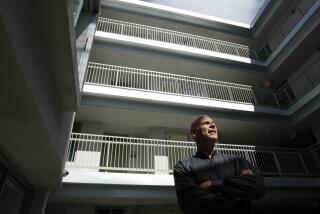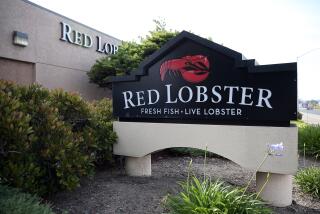Developer, Saudi Partners File for Bankruptcy : Finances: The investors are fighting for control of 20% of the properties on the marina. This action blocks the foreclosure on the Marina del Rey Hotel scheduled for today.
Marina del Rey’s biggest developer and his Saudi Arabian partners, locked in a bitter battle for control of about one-fifth of the property in the marina and faced with imminent foreclosure by the first in a line of lenders, filed for federal bankruptcy protection Wednesday.
The action by Abraham M. Lurie and his Saudi partners in U.S. Bankruptcy Court in Los Angeles blocks Great Western Bank from foreclosing on the Marina del Rey Hotel this morning.
Still very much unresolved, however, is who will ultimately control the marina leases at the center of the dispute. The entire marina is owned by Los Angeles County, and businesses there operate on public land through long-term leases--generally 60 years--that can be bought and sold much like conventional real estate.
Together, Lurie and an investment group headed by billionaire Saudi businessman Abdul Aziz al Ibrahim, a brother-in-law of King Fahd, control leases on three hotels, two apartment complexes, offices, shops, restaurants, more than 1,100 boat slips as well as the last undeveloped piece of waterfront property in the marina.
Although they had previously warned that a bankruptcy filing could cast a cloud over the marina and potentially dampen future investment, county officials on Wednesday tried to put a positive face on the latest development.
“Obviously we are disappointed to see any business in the marina run into financial difficulties--especially when multiple leaseholds are involved and the owner/operator has had a long history of successful operation and heavy involvement in civic affairs,” said Ted Reed, director of the county Department of Beaches and Harbors.
“We don’t feel that the business climate of the marina will be negatively impacted--either in the short or long term--to any significant degree,” Reed added. “Bankruptcy is used increasingly as a business tool,” he said, “to manage corporate affairs and to manage debt.”
Because of the deep differences between Lurie and the Saudis, their partnership, Marina International Properties Ltd., stopped making payments early this year on $130 million in loans from five banks. Four of the banks have declared the loans in default, and foreclosure sales had been scheduled for today and later this month.
The Chapter 11 bankruptcy filing will temporarily block the foreclosures, give the estranged partners protection from creditors and time to reorganize their partnership.
However, the Saudis appear determined to take control of the marina holdings. Lurie insists they are trying to squeeze him out of the marina.
He contends the Saudis forced the bankruptcy so they can buy the leases at “fire sale prices.” Such depressed prices or a foreclosure on his marina holdings could have a devastating effect on the value of all other county-owned land in the marina, Lurie said.
But in a statement, the Saudi investors said they invested heavily in the marina and remain committed to the area.
Charles Wallace, president of the Marina Group of Companies, the Century City-based arm of the Saudi investors, expressed confidence that the bankruptcy court will offer a neutral place to settle the impasse between Lurie and the Saudis.
The extent of their differences was evident in March when the Saudis filed suit against Lurie seeking to dissolve the partnership. In court filings, they accused Lurie of engaging in “fraud and abuse” and treating them as financial “deep pockets” rather than partners.
The lawsuit contends that the relationship with Lurie has been rocky from the start, with both sides “deadlocked” and “unable to agree on matters.”
That partnership began in earnest in August, 1989, when the Saudis paid $21.8 million for a 49.9% stake in Lurie’s marina holdings. The deal was structured through a dozen shell companies in California, Luxembourg and the Cayman Islands in an effort to conceal the identity of the investors.
The Los Angeles County Board of Supervisors approved the deal without learning the identity of the investors or probing their background. Instead, the supervisors accepted assurances from the investors’ Chicago attorney, Cornelius J. Sullivan, that the marina’s newest players were successful foreign business people who valued their privacy.
After a two-month investigation, The Times identified Ibrahim as the lead investor and disclosed that the marina deal was the latest in an expanding portfolio of secret U.S. real estate investments by Ibrahim and his partners.
Last fall, Lurie agreed to sell the remaining 50.1% of his marina holdings to the Saudis for $15.3 million. But the deal fell apart amid increasingly bitter recriminations between the parties.
County officials who administer the marina say they believe the partnership’s marina holdings are profitable. Lurie, however, has borrowed heavily against them in recent years. As part of his deal with the Saudis last fall, his partners agreed to assume responsibility for repaying the $130 million in loans outstanding on the marina properties.
Faced with legal and financial problems involving his partners, his ex-wife and former real estate brokers, Lurie filed for personal bankruptcy last month in a bid to protect his own assets.
As the litigation mounted, the partners remained deadlocked and the banks threatened to move against the properties, the Los Angeles Superior Court appointed a retired judge, Robert Lopez, as receiver of the marina holdings. It was Lopez who actually filed for bankruptcy protection Wednesday on behalf of the partners.
Apart from the bankruptcy court, the question of who controls the leases could land in the laps of the County Board of Supervisors. The supervisors would have to approve the Saudis as marina leaseholders if they succeed in winning majority control in the courts.
At stake are leases on the Marina Beach, Marina del Rey and Marina International hotels, the Islander Marina and Admiralty Apartments, Fisherman’s Village, Pier 44, the Marina Beach Shopping Center, Marina West Office Building and an undeveloped 3.7-acre piece of waterfront property.
Lurie, a politically well-connected developer with a reputation as a hard-nosed businessman, is the largest single leaseholder in the marina.
His partner, Ibrahim, is a billionaire with operations in Saudi Arabia, France, Britain, Switzerland and the United States.
Fortune Magazine and the Financial Times of London have reported that Ibrahim and his brother, Khalid, acted as middlemen in the summer of 1984 in a $1-billion oil-for-jetliners barter deal in which Saudia, the Saudi national airline, bought 747 jetliners from Boeing Aircraft Co.
The following year, according to the London Observer, the Ibrahims helped sell an initial order of British warplanes--Tornado fighter-bombers and Hawk training jets--to the Saudi government in a deal U.S. authorities estimated could exceed $30 billion.
Proceeds from the deals thrust the brothers into the ranks of the world’s billionaires. The Observer has reported that the Ibrahims have channeled their arms and aircraft profits into real estate investments while also generating some jealousy within the Saudi royal family because of their access to the king.
Published reports have said the Ibrahims manage the financial affairs of King Fahd’s youngest son, Prince Abdul Aziz al Fahd, but Saudi officials have denied that.
Lurie vs. Saudis: A Chronology Marina del Rey sits on public land--it is owned and administered by the Los Angeles County government. Businesses there operate under long-term leases (generally 60 years) that can be bought and sold much like conventional real estate. * AUGUST, 1989--The marina’s largest developer, Abraham M. Lurie, sells a 49.9% stake in his marina holdings to unidentified foreign investors for $21.8 million. The deal is structured through a dozen shell corporations stretching from Luxembourg to the Cayman Islands to California to conceal the identity of the investors. County supervisors approve the sale without learning--or even asking--who the investors are.
* NOVEMBER, 1989--After a two-month investigation, The Times identifies the lead investor as billionaire Saudi businessman and arms broker Abdul Aziz al Ibrahim, a brother-in-law of Saudi King Fahd. The marina investment is the latest in a series of secret U.S. real estate acquisitions by Ibrahim and his partners. Their portfolio includes the Ritz-Carlton hotels in New York, Washington and Houston, an unfinished hotel in Aspen, Colo., a hotel-office complex near Chicago-O’Hare International Airport, largely undeveloped land near Disney World in Florida, and a hotel opposite the Mayo Clinic in Rochester, Minn.
* OCTOBER, 1990--Lurie agrees to sell his remaining 50.1% interest in the marina to the Saudis for $15.3 million, with the Saudis also agreeing to assume more than $130 million in debts on the properties. Los Angeles County demands to know identity of the investors and their background. But the deal collapses and a bitter battle for control of the marina holdings ensues.
* MARCH, 1991--The Saudi investors file suit in Los Angeles Superior Court seeking to dissolve their marina partnership and accusing Lurie of engaging in “fraud and abuse.” Two banks file default notices against the partnership for failure to make payments on $75 million in loans.
* JUNE, 1991--Lurie, faced with mounting legal problems involving his Saudi partners, his ex-wife and former real estate brokers, files for bankruptcy in a bid to protect his personal assets. A Superior Court judge appoints a receiver to oversee the marina holdings.
* JULY 10, 1991--The day before a scheduled bank foreclosure against one of their marina hotels, Lurie and his partners seek protection under Chapter 11 of the federal bankruptcy code.
More to Read
Inside the business of entertainment
The Wide Shot brings you news, analysis and insights on everything from streaming wars to production — and what it all means for the future.
You may occasionally receive promotional content from the Los Angeles Times.










